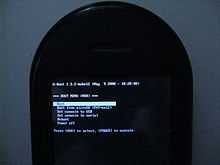Das U-Boot
| Developer(s) | DENX Software Engineering |
|---|---|
| Initial release | October 15, 1999 |
| Stable release | v2015.01 / January 12, 2015 |
| Development status | active |
| Written in | C |
| Available in | English |
| Type | Boot loader |
| License | GNU GPLv2 and GNU GPLv2+ |
| Website | http://www.denx.de/wiki/U-Boot/ |
Das U-Boot (Universal Bootloader) is an open source, primary boot loader used in embedded devices to package the instructions to boot the device's operating system kernel. It is available for a number of computer architectures, including 68k, ARM, AVR32, Blackfin, MicroBlaze, MIPS, Nios, PPC and x86.
Functionality
Compatible file systems
Device tree
Device tree is a data structure for describing hardware layout. Using Device tree, a vendor might be able to use an unmodified mainline Das U-Boot on otherwise special purpose hardware. As also adopted by the Linux kernel, Device tree is intended to ameliorate the situation in the embedded industry, where a vast number of product specific forks (of Das U-Boot and Linux) exist. The ability to run mainline software practically gives customers indemnity against lack of vendor updates.
History


The project's origin is a 8xx PowerPC bootloader called 8xxROM written by Magnus Damm.[1] In October 1999 Wolfgang Denk moved the project to SourceForge.net and renamed it to PPCBoot, because SF.net did not allow project names starting with digits.[1] Version 0.4.1 of PPCBoot was first publicly released July 19, 2000.
In 2002 a previous version of the source code was briefly forked into a product called ARMBoot, but was merged back into the PPCBoot project shortly thereafter. On October 31, 2002 PPCBoot−2.0.0 was released. This marked the last release under the PPCBoot name, as it was renamed to reflect its ability to work on other architectures besides the PPC ISA.[2][3]
PPCBoot−2.0.0 became U−Boot−0.1.0 in November 2002, expanded to work on the x86 processor architecture. Additional architecture capabilities were added in the following months: MIPS32 in March 2003, MIPS64 in April, Altera NIOS−32 in October, Coldfire in December, and Microblaze in April 2004. The May 2004 release of U-Boot-1.1.2 worked on the products of 216 board manufacturers across the various architectures.[3]
The current name Das U-Boot adds a German definite article, to create a bilingual pun on the German word for "submarine." It is free software released under the terms of the GNU General Public License. It can be built on an x86 PC for any of its intended architectures using a cross development GNU toolchain, for example crosstool, the Embedded Linux Development Kit (ELDK) or OSELAS.Toolchain.
The importance of Das U-Boot in embedded Linux systems is quite succinctly stated in the book Building Embedded Linux Systems, by Karim Yaghmour, whose text about U-Boot begins, "Though there are quite a few other bootloaders, 'Das U-Boot,' the universal bootloader, is arguably the richest, most flexible, and most actively developed open source bootloader available."[4]
Usages
- LibreCMC: The Free Software Foundation endorsed GNU/Linux distribution LibreCMC[5] is an OpenWrt-based distribution without non-free software or binary blobs. LibreCMC is made up of various software components and one of them is a heavily modified version of u-boot, from upstream sources of U-Boot.[6]
- The ARM-based Chromebooks ship with Das U-Boot. The Celeron- and i5-based Chromebooks use it as payload for coreboot.[7]
- SAM440ep and SAM460ex by Acube AmigaOS board use UBoot. Also A-EON AmigaOnex1000 successor system, X5000 will also use Uboot.
See also
References
- ↑ 1.0 1.1 PPCBoot Homepage: Authors
- ↑ "[PPCBoot-users] Halloween release of PPCBoot: 2.0.0 - the Final Release.", Wolfgang Denk, 31 October 2002
- ↑ 3.0 3.1 "U-Bootdoc History". Retrieved Sep 4, 2011.
- ↑ Building Embedded Linux Systems by Kareem Yaghmour, Chapter 9
- ↑ https://www.gnu.org/distros/free-distros.html
- ↑ http://librecmc.org/librecmc/wiki?name=News
- ↑ coreboot tutorial oscon 2013, p. 6
External links
- Official website
- Official git repository
- Barebox (formerly known as U-Boot-V2)
- ARMboot